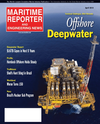
Page 36: of Maritime Reporter Magazine (April 2, 2010)
Read this page in Pdf, Flash or Html5 edition of April 2, 2010 Maritime Reporter Magazine
36 Maritime Reporter & Engineering News ral Júlio Soares de Moura Neto. The base will house the new Scorpene submarine fleet and eventually the first nuclear sub- marine made in Brazil with French tech- nology.
Four conventional submarines of the
Scorpene class are scheduled to be con- structed up to 2016, with the conclusion of the nuclear submarine scheduled for 2020. The total Navy budget for 2010 is approximately R$4.3 billion ($2.3 billion at present currency levels). From this budget R$2.3b is slated for the sub- marines and R$2b for investments in the fleet and fleet maintenance. In terms of national content, there are already 36,000 items listed to be supplied for the sub- marines by national companies and the list of potential national suppliers is still growing.
The commander of the Brazilian Navy is feeling very optimistic about the budget being guaranteed. “The govern- ment has just released the first install- ment of the resources for the project. We will be able to conduct our submarine program. It is a National project and a strategic partnership signed between two countries” said Fleet Admiral Julio
Soares de Moura Neto.
Scorpene Diesel Submarine fleet and the Nuclear Submarine Program
Since the 1970s, the Brazilian Navy concluded that the vastness of the At- lantic Ocean and the magnitude of
Brazilian interests at sea demanded the use of conventional submarines working in conjunction with at least one nuclear submarine.
Approximately 95% of Brazilian trade (imports and exports) takes place at sea and the growing importance of the off- shore oil fields to the Brazilian economy is a growing factor. There have also been historical confrontations related to fish- eries along the Brazilian EEZ. This new submarine fleet and in particular the nu- clear submarine, is considered of strate- gic importance by the Brazilian Navy due to its mobility, stealth and the versatility of its operational parameters, which per- mit it not only to effectively patrol close to shore but also as an advanced defense of distant marine frontiers.
It is important to remember that the
Brazilian coast is over 7,000 km (around 4,500 miles) long and the Brazilian EEZ encompasses an area of 3.5 million sq. km., which may rise to 4.4 million sq. km. depending on approval of extension requests made by the Brazilian govern- ment to the United Nations. The EEZ goes out to 200 nautical miles (370 km) from the coast and there are sources that guarantee that pre-salt reservoirs will be found all the way to that limit of the EEZ and possibly beyond.
Obviously four or five submarines, even if one of them is nuclear powered, will never be enough to patrol or defend the whole EEZ, so the Brazilian Navy will also have to re-equip and upgrade its surface navy.
DCNS presently exports the Scorpene submarine to the Chilean, Indian and
Malaysian Navies. DCNS is considered
FEATURE BRAZIL’S NUCLEAR SUBMARINE
Chilean Navy Scorpene Submarine. (Photo cr edit Armada Chilena)

 35
35

 37
37
